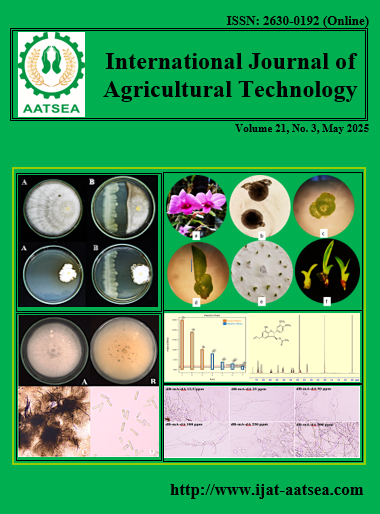Assessment of bioactive compounds and synergistic efffects from Miliusa sessilis plant against anthracnose diseases on mango fruits (Mangifera indica L. 'Nam Dok Mai Si Thong')
Main Article Content
Abstract
Three bioactive neolignans: dehydrodieugenol A (dA), dehydrodieugenol B (dB), and miliusin A (mA) were purified from Miliusa sessilis (MSE). The bioactive compounds (dA, dB, mA, dB-mA, mA-dA and dB-dA) at concentrations of 50, 100, 500, 1000, 2000, 3000, 4000 and 5000 ppm were carried out to determine antifungal activity for controlling Colletotrichum sp. The result showed that dB-dA at 5000 ppm inhibited mycelium growth by 43.46%, while dA and dB had a high fungal inhibition effect of 43.46% and 45.50%, respectively. However, there was no significant difference in these compounds (p<0.01). Furthermore, the potential antifungal activity using poison food technique revealed the greatest percentage inhibition in significant difference (p<0.01) compared to control and all treatments at 1000 ppm of mA, dA and dB-dA as 76.07%, 75.38% and 74.79%, respectively. The MIC values of dA, dB-mA, mA-dA and dB-dA were 6.25 ppm exceptionally; dB and mA had higher MIC values (12.5 ppm). In vivo antifungal activity evaluation, MSE had efficacy to suppress and reduce lesions on mango fruits. These findings supported that the synergism of MSE and showed strong antifungal effects and could be developed as an alternative to synthetic fungicides.
Article Details

This work is licensed under a Creative Commons Attribution-NonCommercial-NoDerivatives 4.0 International License.
References
Alexopoulos, C. O., Mims, C. W. and Blackwell, M. (1996). Introductory mycology. In: 4th ed. John Wiley and Sons Inc, Wiley, New York, pp.880.
Amenu, D. (2014). Antimicrobial activity of medicinal plant extracts and their synergistic effect on some selected pathogens. American Journal of Ethnomedicine, 1:18-29.
Barnett, H. L. and Hunter, B. B. (1986). Illustrated genera of imperfect fungi. In: 4th ed. Macmillan Publishing Co., New York.
Chaowasku, T. and Kessler, P. J. (2014). Miliusa cambodgensis sp. nov. (Annonaceae) from Cambodia and M. astiana, M. ninhbinhensis spp. nov. from Vietnam. Nordic Journal of Botany, 32:298-307.
Costa-Silva, T. A. D., Grecco, S. S., De Sousa, F. S., Lago, J. H. G., Martins, E. G., Terrazas, C. A., Varikuti, S., Owens, K. L., Beverley, S. M., Satoskar, A. R. and Tempone, A. G. (2015) Immunomodulatory and antileishmanial activity of phenylpropanoid dimers isolated from Nectandra leucantha. Journal of Natural Products, 78:653-657.
De Diaz, A. M. P., Gottlieb, H. E. and Gottlieb, O. R. (1980). Dehydrodieugenols from Ocotea cymbarum. Phytochemistry, 19:681-682.
de Guzman Alvindia, D. and Mangoba, M. A. A. (2020). Bioactivities of Allium longicuspis Regel against anthracnose of mango caused by Colletotrichum gloeosporioides (Penz.). Scientific Reports, 10:11367.
Efferth, T. and Koch, E. (2011). Complex interactions between phytochemicals. The multi-target therapeutic concept of phytotherapy. Current drug targets, 12:122-132.
Food and Agriculture Organization of the United Nations. (2024). Major Tropical Fruits Market Review – Preliminary results 2023. Rome, Italy, 17 p.
Harvey, A. L. (2008). Natural products in drug discovery. Drug Discovery Today, 13:894-901.
Hosseini-Zare, M. S., Sarhadi, M., Zarei, M., Thilagavathi, R. and Selvam, C. (2021). Synergistic effects of curcumin and its analogs with other bioactive compounds: A comprehensive review. European Journal of Medicinal Chemistry, 210:113072.
Kursa, W., Jamiołkowska, A., Wyrostek, J. and Kowalski, R. (2022). Antifungal effect of plant extracts on the growth of the cereal pathogen Fusarium spp.—An In Vitro Study. Agronomy, 12:3204.
Mahadtanapuk, S., Sanguansermsri, M., Cutler, R. W., Sardsud, V. and Anuntalabhochai, S. (2007). Control of anthracnose caused by Colletotrichum musae on Curcuma alismatifolia Gagnep. using antagonistic Bacillus spp. American Journal of Agricultural and Biological Sciences, 2:54-61.
Paull, R. E. and Duarte, O. (2011). Tropical Fruits. Vol. 1. In: 2nd ed. CABI Publishing, London, UK, pp.440.
Peralta-Ruiz, Y., Rossi, C., Grande-Tovar, C. D. and Chaves-López, C. (2023). Green management of postharvest anthracnose caused by Colletotrichum gloeosporioides. Journal of Fungi, 9:623.
Rattanakreetakul, C., Keawmanee, P., Bincader, S., Mongkolporn, O., Phuntumart, V., Chiba, S. and Pongpisutta, R. (2023). Two newly identified Colletotrichum species associated with mango anthracnose in central thailand. Plants, 12:1130.
Sitarek, P., Merecz-Sadowska, A., Kowalczyk, T., Wieczfinska, J., Zajdel, R. and Śliwiński, T. (2020). Potential synergistic action of bioactive compounds from plant extracts against skin infecting microorganisms. International Journal of Molecular Sciences, 21:5105.
Son, N. T. (2019). Genus Miliusa: A review of phytochemistry and pharmacology. Evidence-Based Complementary and Alternative Medicine, 1-29.
Sukatta, U., Haruthaithanasan, V., Chantarapanont, W., Dilokkunanant, U. and Suppakul, P. (2008). Antifungal activity of clove and cinnamon oil and their synergistic against postharvest decay fungi of grape in vitro. Agriculture and Natural Resources, 42:169-174.
Pootaeng-on, Y., Charoensuksai, P., Wongprayoon, P., Jiajaroen, S., Chainok, K. and Rayanil, K. (2020). Miliusins; cytotoxic neolignans from the leaves of Miliusa sessilis. Phytochemistry, 176:112417.
Vaou, N., Stavropoulou, E., Voidarou, C. C., Tsakris, Z., Rozos, G., Tsigalou, C. and Bezirtzoglou, E. (2022). Interactions between medical plant-derived bioactive compounds: focus on antimicrobial combination effects. Antibiotics (Basel, Switzerland), 11:1014.
Wagner, H. and Ulrich-Merzenich, G. (2009). Synergy research: approaching a new generation of phytopharmaceuticals. Phytomedicine, 16:97-110.
Zanna, H., Tijani, Y., Abubakar, S., Modu, B., Damasak, A. A. and Uzairu, S. M. (2021). Fungicidal potential of selected plant extracts against human pathogenic fungi. Scientific African, 13:1-6.


